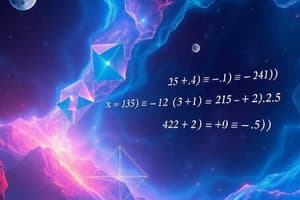Podcast
Questions and Answers
To solve the exponential equation $5^{2x+1} = 125$, which of the following is the correct first step?
To solve the exponential equation $5^{2x+1} = 125$, which of the following is the correct first step?
- Express 125 as $5^3$. (correct)
- Subtract 1 from both sides.
- Take the logarithm of both sides.
- Divide both sides by 5.
Given the equation $4^{x} = 8^{(x-1)}$, identify the correct common base to rewrite both sides of the equation.
Given the equation $4^{x} = 8^{(x-1)}$, identify the correct common base to rewrite both sides of the equation.
- 2 (correct)
- 8
- 16
- 4
Solve for x in the equation $9^{x+1} = 27^{x}$.
Solve for x in the equation $9^{x+1} = 27^{x}$.
- x = -2
- x = 2 (correct)
- x = 3
- x = -3
What is the value of x in the equation $2^{x} = 10$, rounded to four decimal places?
What is the value of x in the equation $2^{x} = 10$, rounded to four decimal places?
Solve for x in the equation $e^{2x} = 5$.
Solve for x in the equation $e^{2x} = 5$.
Determine the value of x in the following equation: $7 + 3^{x-4} = 16$
Determine the value of x in the following equation: $7 + 3^{x-4} = 16$
Find x if $5 + 2e^{2-x} = 11$.
Find x if $5 + 2e^{2-x} = 11$.
Solve for x: $2^{x^2 - x} = \frac{1}{4}$
Solve for x: $2^{x^2 - x} = \frac{1}{4}$
Determine the solutions for x in the equation $5^{x^2} \cdot 5^{2x} = 625$.
Determine the solutions for x in the equation $5^{x^2} \cdot 5^{2x} = 625$.
Given $9^{x} - 10 \cdot 3^{x} + 9 = 0$, use substitution to find the values of x.
Given $9^{x} - 10 \cdot 3^{x} + 9 = 0$, use substitution to find the values of x.
Find the value of x in the equation: $2^{2x} - 3 \cdot 2^{2x-2} = 5$.
Find the value of x in the equation: $2^{2x} - 3 \cdot 2^{2x-2} = 5$.
How can you express the equation $4^{3x+2} = 8^{x-1}$ using a common base?
How can you express the equation $4^{3x+2} = 8^{x-1}$ using a common base?
Given $25^{x} - 6 \cdot 5^{x} + 5 = 0$, use substitution to find the values of x.
Given $25^{x} - 6 \cdot 5^{x} + 5 = 0$, use substitution to find the values of x.
Flashcards
Solving Exponential Equations
Solving Exponential Equations
Express both sides of the equation with the same base, then equate the exponents and solve.
Changing Bases Technique
Changing Bases Technique
Convert numbers in the equation to a common base, then set the exponents equal to each other.
Solving with Logarithms
Solving with Logarithms
Apply log or natural log (ln) to both sides of the equation to solve for the variable.
Isolating Exponential Terms
Isolating Exponential Terms
Signup and view all the flashcards
Solving Equations with Base e
Solving Equations with Base e
Signup and view all the flashcards
Fractions in Exponents
Fractions in Exponents
Signup and view all the flashcards
Multiplying Exponential Terms
Multiplying Exponential Terms
Signup and view all the flashcards
Substitution in Exponentials
Substitution in Exponentials
Signup and view all the flashcards
Factoring out GCF
Factoring out GCF
Signup and view all the flashcards
Study Notes
Solving Exponential Equations with the Same Base
- To solve an exponential equation, aim to express both sides with the same base.
- If bases are equal, then exponents must also be equal.
- For example, in 3^(x+2) = 9^(2x-3), convert 9 to 3^2, then equate the exponents.
- When raising one exponent to another, multiply them (e.g., (3^2)^(2x-3) becomes 3^(4x-6)).
Techniques for Changing Bases
- Convert numbers to a common base to solve exponential equations.
- Recognizing common bases is crucial (e.g., 8 and 16 can both be expressed as powers of 2).
- After establishing a common base, set the exponents equal to each other.
Solving Exponential Equations by Converting to a Common Base (Example)
- Starting equation: 8^(4x-12) = 16^(5x-3)
- Convert 8 to 2^3 and 16 to 2^4: (2^3)^(4x-12) = (2^4)^(5x-3)
- Multiply exponents: 2^(12x-36) = 2^(20x-12)
- Set exponents equal: 12x - 36 = 20x - 12
- Solve for x: x = -3
Common Bases
- 27 and 81 can both be expressed as powers of 3.
Solving Exponential Equations Using Logarithms
- Logarithms can be used to solve exponential equations when you can't easily manipulate to get the same base
- Apply log or natural log (ln) to both sides of the equation
Using Logarithms to Solve for x
- In the equation 3^x = 8, take the log of both sides: log(3^x) = log(8).
- Use the power rule to move the exponent: x * log(3) = log(8).
- Isolate x: x = log(8) / log(3).
- Calculate x: x ≈ 1.8928.
Natural Logarithms
- Natural logarithms (ln) are particularly useful when dealing with the base e.
- If e^x = 7, take the natural log of both sides: ln(e^x) = ln(7).
- Simplify: x * ln(e) = ln(7), where ln(e) = 1, so x = ln(7).
- Decimal approximation: x ≈ 1.9459.
Isolating Exponential Terms Before Applying Logarithms
- Simplify the equation by isolating the exponential term.
- Apply logarithms after isolating the exponential term.
- Solve for x after applying logarithms and using log properties.
- In the equation 5 + 4^(x-2) = 23, subtract 5 from both sides to get 4^(x-2) = 18.
- Apply log to both sides: log(4^(x-2)) = log(18).
- Move the exponent: (x - 2) * log(4) = log(18).
- Isolate x: x = 2 + log(18) / log(4).
- Calculate x: x ≈ 4.08496.
Solving Exponential Equations with Base e
- For equations with base e, use natural logarithms (ln).
- Before taking the natural log, isolate the exponential term.
- Use properties of logarithms to solve for x.
- If 3 + 2e^(3-x) = 7, isolate the exponential term to get 2e^(3-x) = 4.
- Divide by 2: e^(3-x) = 2.
- Apply ln to both sides: ln(e^(3-x)) = ln(2).
- Simplify: 3 - x = ln(2).
- Solve for x: x = 3 - ln(2).
- Approximation: x ≈ 2.3069.
Exponential Equation with Variable in the Exponent and a Fraction
- Rewrite fractions with negative exponents to match bases.
- Set the exponents equal after establishing common bases.
- Solve for x after equating the exponents.
- If 3^(x^2 + 4x) = 1/27, rewrite as 3^(x^2 + 4x) = 3^(-3).
- Then, x^2 + 4x = -3.
- Rewrite as x^2 + 4x + 3 = 0.
- Factor: (x + 3)(x + 1) = 0.
- Solutions: x = -3, x = -1
Solving Exponential Equations with Combined Terms
- When multiplying terms with the same base, add the exponents.
- Factor the resulting quadratic equation to find solutions for x.
- Check solutions by substituting back into original equation.
- For 2^(x^2) * 2^(3x) = 16, rewrite as 2^(x^2 + 3x) = 2^4.
- Then, x^2 + 3x = 4.
- Rewrite as x^2 + 3x - 4 = 0.
- Factor: (x + 4)(x - 1) = 0.
- Solutions: x = -4, x = 1
Substitution to Simplify Factoring
- Use substitution to reduce to a quadratic equation when direct factoring isn't obvious.
- Factor the quadratic equation and solve for the substitute variable.
- Substitute back to find values for the original variable x.
- For 4^(2x) - 20 * 4^x + 64 = 0, let a = 4^x, then the equation becomes a^2 - 20a + 64 = 0.
- Factor: (a - 16)(a - 4) = 0.
- Solutions: a = 16, a = 4.
- If a = 16, 4^x = 16, so x = 2.
- If a = 4, 4^x = 4, so x = 1
Factoring Out the Greatest Common Factor (GCF)
- When terms have a common exponential expression, factor out the GCF.
- Simplify and solve for x.
- For 3^(2x) - 3^(2x-1) = 18, factor out 3^(2x) to get 3^(2x) * (1 - 3^(-1)) = 18.
- Simplify: 3^(2x) * (1 - 1/3) = 18.
- Further simplification: 3^(2x) * (2/3) = 18.
- Multiply by 3/2: 3^(2x) = 27.
- Rewrite 27 as 3^3 so, 3^(2x) = 3^3, thus 2x = 3.
- Solve for x: x = 3/2.
Studying That Suits You
Use AI to generate personalized quizzes and flashcards to suit your learning preferences.




